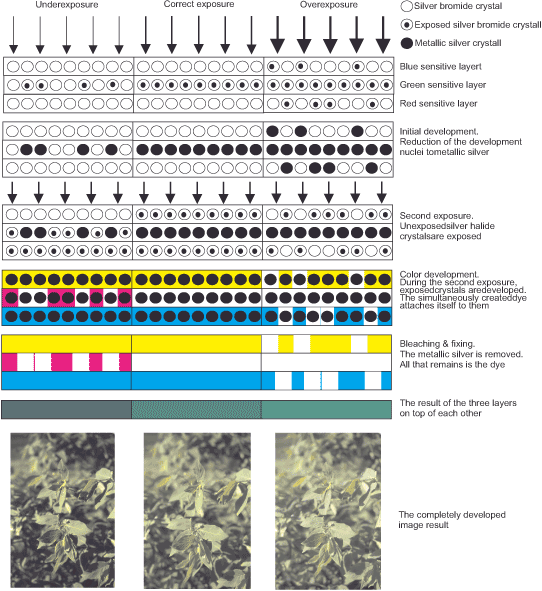You are here: Nature Science Photography – Lightness and color – Lightness and color in photography
Basically, reversal film has the same layer structure as negative film, with one blue-sensitive, one green-sensitive and one red-sensitive layer each. However, the development process involves two steps. First, we develop a negative using a black-and-white developer. This produces a black-and-white negative that is still light-sensitive in the unexposed areas. We then expose the film a second time with a precisely metered amount of light (in practical processes, we use a so-called reversal bath for this purpose), which also creates development nuclei in the non-exposed negative areas. Only at this point does the actual color development occur, leading to the reduction of the development nuclei from the second exposure into metallic silver. It is at precisely these points that the dyes are formed in this step by the reaction of the color couplers with the oxidation products of the color developer. At this point, the layer consists of silver at the sites exposed during the exposure and silver plus dye at the sites exposed during the second exposure. – It is not hard to guess that it is completely black for this reason. Only the subsequent bleaching and fixing baths wash out all the silver, leaving only the transparent dyes in their places not exposed in the original exposure, where they give a directly visible positive image.
Here’s how it works by color layer: The original incident red light exposed the blue-green layer. A negative silver image was formed there. Consequently, the dyes are formed in the purple and yellow layers, which were only activated by the second exposure. When light passes through the finished slide, the yellow dye removes the blue components, and the purple dye removes the green color components. Only the red part of the spectrum remains. In the first step, green light exposes the purple layer, which produces a silver image. The second exposure stimulates the yellow and blue-green layers, which form corresponding dyes. Yellow and blue-green reduce the incident light by blue and red, respectively, and only green remains. Blue light has first exposed the yellow layer, and the dyes form in the purple and blue-green layers. Thus, the white light loses its green and red components when viewed, allowing blue to shine through.

Next Electronic image carriers and digital technology
Main Lightness and Color
Previous Analog image carriers – negative film
If you found this post useful and want to support the continuation of my writing without intrusive advertising, please consider supporting. Your assistance goes towards helping make the content on this website even better. If you’d like to make a one-time ‘tip’ and buy me a coffee, I have a Ko-Fi page. Your support means a lot. Thank you!


 Since I started my first website in the year 2000, I’ve written and published ten books in the German language about photographing the amazing natural wonders of the American West, the details of our visual perception and its photography-related counterparts, and tried to shed some light on the immaterial concepts of quantum and chaos. Now all this material becomes freely accessible on this dedicated English website. I hope many of you find answers and inspiration there. My books are on
Since I started my first website in the year 2000, I’ve written and published ten books in the German language about photographing the amazing natural wonders of the American West, the details of our visual perception and its photography-related counterparts, and tried to shed some light on the immaterial concepts of quantum and chaos. Now all this material becomes freely accessible on this dedicated English website. I hope many of you find answers and inspiration there. My books are on